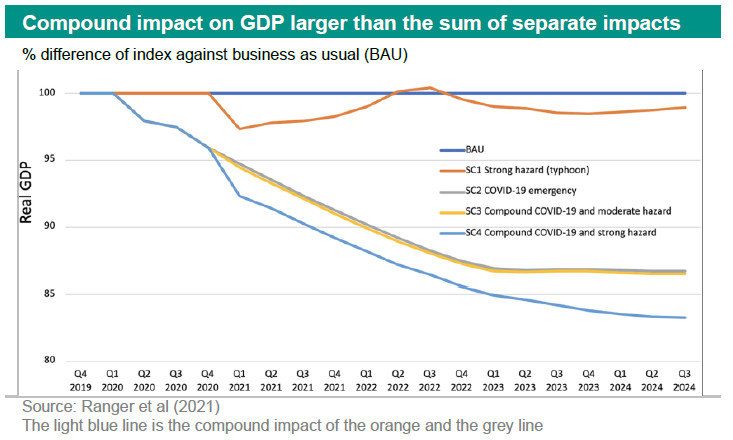ESG - Compound risks in climate scenarios: is the impact greater than the sum of the parts?

When using climate scenarios, it is important to be aware of the assumptions underlying, and limitations of, these scenarios. One of the limitations of current climate scenarios and models is that they do not incorporate compound risks. Compound risk can occur when more than one shock or hazard occurs in combination. The impacts on the economy and society can be non-linear, complex and the total impact may be more than the sum of the individual parts due to interactions between the shocks within for instance the environment, firms, households, and/or the economy at large. In this note, we explore compound risk and its potential drivers/transmission mechanisms. We find that these risks can be material and relevant.
If a climate shock combines with another (climate or otherwise) shock, these shocks may interact and compound
This compound risk may often be material and relevant
Transmission mechanisms are dependent on combination of shocks and country specifics
Indirect effects may be larger than the direct impact
Current models/tools are not equipped to fully quantify compound risk and therefore may well understate negative economic impacts
Combined shocks can interact and strengthen one another
A climate shock can combine with another shock of any origin. A physical climate shock can occur in combination with another physical climate shock, but also with a transition climate shock or any other shock, such as economic, financial, or other environmental. For instance, in 2020, many countries saw record-breaking extreme weather at the same time that the global Covid-19 pandemic unfolded (see for example ). As businesses and government coffers were already depleted by the pandemic, the shock absorption capacity for the weather-related damage was smaller and the impact thus larger. Going forward, a combination of climate and environmental risk seems a relevant example: there’s increasing recognition that climate change and biodiversity loss are linked together, resulting in underestimation of risk if only the climate damages are taken into account.
Research suggests that compound risks are often material and relevant
So how could such a compound shock be transmitted into the economy? The first-order effects of a shock are direct damages of the shock. Secondly, there are the indirect impacts on the economy as a whole and actors in it. In both the first and second order effects, there could be compounding impacts.
These compounding impacts should be dependent on hazard- and country specifics. combine a physical climate hazard and a Covid-19 emergency in different scenarios. In this example, firms’ revenues and production is hit by capital stock destruction from the natural disaster, while it is also hit by declining economic activity from the covid-19 emergency. This in turn hit firms’ profitability, which in turn transmits into, among others, employment and firms’ creditworthiness. This example also illustrates how indirect impacts can be larger than direct impacts. The indirect impact of both shocks in this example is on firms’ production and household demand, amplifying the impact. This in turn can then affect employment, wages, and households’ wealth, and this then creates a feedback on demand. This can lead to long-lasting effects on the economy. This study finds that the indirect impacts can be 50% larger than the scale of the sum of the individual shocks. Other research on historical instances of compound events also suggests that many major crises are caused by compound effects. The interaction of risks can give rise to a prolonged out of equilibrium state of he economy. Firms, households, and investors behave differently in these circumstances. The uncertainty leads to risk aversion and economic scarring. In particular, this refers to long-lasting effects and slow recovery (hysteresis).

Current models/tools are not equipped to fully quantify compound risk
Current climate scenarios do not (fully) include compound risks. Firstly, these risks are very uncertain and challenging to assess quantitatively, in both probability and severity. In addition, the current generation of tools and models are currently limited in their ability to capture compound shocks. For instance catastrophe (cat) models (the CLIMADA model that is used for modelling flood and tropical typhoon risk in the phase IV NGFS scenario is such a cat model), which are used to estimate the direct impacts of climate-related shocks, cannot capture compound shocks or indirect impacts.
Integrated Assessment Models (IAMs), a common tool for economic impact assessment of climate change, assume that the impact of extreme weather events can be represented as damage functions that connect temperatures to economic losses. This assumption limits the ability of the current generation of IAMs to capture the effects of compounding climate shocks. Such impacts would need to be included in the form of an adjustment of the damage functions. In addition, the macroeconomic model transmitting the climate scenario into the general macro economy usually is a general equilibrium model. These models typically assume that agents have rational expectations and hysteresis plays no role. They rely on equilibrium assumptions which may not be valid.
Conclusion
Compound risks seem to be material and relevant in many instances. Compound risks are not completely taken into account in current models and tools. As a result, risk is underestimated. This underestimation could be harmful if observers are not aware of this. Impacts flowing from climate scenarios should be used recognizing the limitations.
